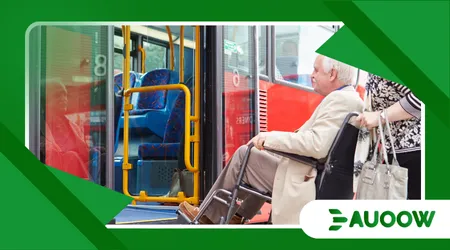The Real Impact of Accessibility Mandates in Public Transportation

Impact of accessibility mandates in public transportation shapes how cities move, live, and include.
These regulations, driven by laws like the Americans with Disabilities Act (ADA) and the European Accessibility Act (EAA), aim to make buses, trains, and stations usable for everyone, regardless of physical or cognitive ability.
But what does this mean in practice? Beyond compliance, these mandates redefine urban mobility, social equity, and economic opportunity.
This article dives into the tangible effects of these policies, exploring their successes, challenges, and the human stories behind them. Why should we care?
Because accessible transit isn’t just infrastructure it’s a lifeline for millions.
In 2025, accessibility mandates are no longer optional; they’re a global priority.
The EAA, fully enforced by June 28, 2025, demands that EU public and private transport services meet Web Content Accessibility Guidelines (WCAG) 2.2 AA standards.
In the U.S., the Department of Transportation’s recent rule, effective January 17, 2025, sets clear standards for pedestrian facilities like transit stops.
These policies push for ramps, tactile paving, and real-time audio announcements, but their ripple effects go deeper.
They challenge cities to rethink design, budgets, and priorities while empowering people with disabilities to navigate independently.
Yet, compliance isn’t universal, and gaps persist.
Let’s unpack explore the impact of accessibility mandates in public transportation through real-world examples, data, and a fresh perspective.
A Lifeline for Inclusion
Consider Maria, a wheelchair user in Chicago. Before the CTA’s 2019-2023 accessibility upgrades, she relied on costly paratransit to reach her job.
Now, with elevator-equipped stations, she rides the L train independently. This is the impact of accessibility mandates in public transportation freedom to work, socialize, and live.
Studies, like one from the European Commission in 2023, show 80 million EU citizens with disabilities benefit from similar upgrades, boosting workforce participation.
Yet, mandates face resistance. Retrofitting old systems, like London’s 150-year-old Underground, costs billions.
Operators argue funds divert from other priorities, but inclusion isn’t optional it’s a right.
++ How Disability Laws Differ Across Europe: A Country-by-Country Breakdown
Accessible transit also benefits parents with strollers, seniors, and tourists, amplifying the impact of accessibility mandates in public transportation.
The ripple effect is economic. Accessible systems attract diverse riders, increasing fare revenue.
Cities like Vienna, crowned 2025’s Access City, saw tourism rise after transit upgrades, proving inclusion drives growth. Mandates don’t just open doors; they build stronger economies.

Balancing Costs and Equity
Retrofitting stations or buying low-floor buses isn’t cheap. In the U.S., the Federal Transit Administration estimated in 2022 that full ADA compliance for rail systems could cost $10 billion over a decade.
Operators face a tough choice: raise fares or cut services? This tension underscores the impact of accessibility mandates in public transportation on budgets.
But costs aren’t the full story. Equity demands action. Without accessible transit, people with disabilities face exclusion, unemployment, and isolation.
Sweden’s 2019 study on perceived accessibility found frequent transit use correlates with higher social inclusion, especially in rural areas. Mandates force tough but necessary trade-offs.
Smaller cities struggle most. Unlike New York or Berlin, they lack funds for upgrades. Yet, exemptions for “undue burden” under the EAA risk uneven access.
Read more: Car tax exemptions for people with disabilities: international guide
Equity requires consistent enforcement, ensuring no one’s left behind, regardless of zip code.
Technology as a Game-Changer
Real-time audio announcements and mobile apps transform transit. In Tokyo, JR East’s 2024 app offers tactile navigation for visually impaired riders.
This tech, mandated by accessibility laws, shows the impact of accessibility mandates in public transportation on innovation.
But tech isn’t a cure-all. Rural areas often lack reliable internet, limiting app-based solutions. Over-reliance on digital tools can exclude older or low-income riders.
Mandates must balance high-tech with low-tech fixes, like tactile paving or clear signage.
Smart cities like Singapore integrate AI to predict elevator maintenance, minimizing downtime. Such innovations, spurred by mandates, benefit all riders.
Technology, when inclusive, amplifies accessibility’s reach, but human-centered design remains key.
Social and Cultural Shifts
Accessibility mandates do more than change infrastructure they shift mindsets. In Brazil, São Paulo’s 2023 campaign, “Empathy on Board,” paired accessibility upgrades with rider education.
The result? Fewer complaints and more courtesy toward disabled passengers. This cultural impact of accessibility mandates in public transportation fosters empathy.
Yet, stigma persists. Some riders view accommodations as “special treatment.”
Education campaigns, like Toronto’s 2024 “Access for All,” counter this by highlighting universal benefits. Accessibility isn’t charity; it’s justice.
Grassroots advocacy drives change. In India, disability activists pushed for audible signals at Delhi Metro stations, implemented in 2024.
These victories show mandates succeed when communities demand accountability, amplifying their social impact.
Policy Gaps and Future Challenges
Mandates aren’t perfect. In the U.S., only 70% of Amtrak stations were ADA-compliant by 2023, per a DOT report. Enforcement lags, leaving rural riders stranded.
The impact of accessibility mandates in public transportation hinges on closing these gaps.
Global disparities also loom. While the EAA sets a high bar, developing nations often lack resources.
India’s 2016 Rights of Persons with Disabilities Act mandates accessibility, but implementation is spotty. Global cooperation, like UN initiatives, could bridge this divide.
Emerging tech, like autonomous shuttles, poses new questions. Will they be accessible?
Mandates must evolve to address automation, ensuring future systems prioritize inclusion. Policy agility is critical.
Measuring Success Through Data
Data reveals the impact of accessibility mandates in public transportation. Below, a 2023 EU study highlights accessibility’s benefits:
| Metric | Before Mandates (2018) | After Mandates (2023) |
|---|---|---|
| Disabled workforce participation | 47% | 53% |
| Public transit ridership (disabled) | 12% | 19% |
| User satisfaction (accessibility) | 62% | 78% |
This table shows mandates boost employment and ridership. Yet, satisfaction gaps suggest room for improvement, especially in rural areas.
Looking ahead, metrics like “transit desert” mapping used in Los Angeles to identify underserved areas can guide investments.
Data-driven policies ensure mandates deliver equitable outcomes, not just compliance.
A Broader Lens: Universal Design
Accessibility mandates spark universal design, benefiting all. Think of a low-floor bus: it helps wheelchair users, but also parents, delivery workers, and seniors.
This is the impact of accessibility mandates in public transportation solutions that serve everyone.
Take curb cuts. Mandated for wheelchairs, they ease navigation for cyclists and skaters. Universal design flips the script: instead of retrofitting for “others,” it builds systems for all from the start.
Cities like Copenhagen embrace this, with transit hubs designed for seamless use.
Yet, universal design requires upfront investment. Planners must prioritize it over short-term savings.
Mandates push this shift, ensuring transit systems are inherently inclusive, not patched together.
Real-World Stories and Analogies

Picture transit as a city’s circulatory system. Accessibility mandates are like unclogging arteries, letting everyone disabled or not flow freely.
Without them, the system falters, starving communities of opportunity. This analogy captures the impact of accessibility mandates in public transportation.
Or meet Ahmed, a blind student in Cairo. Before 2024’s audio-equipped trams, he missed classes due to unreliable taxis.
Now, he navigates confidently, graduating on time. Stories like his show mandates aren’t abstract they change lives.
Contrast this with rural Kenya, where inaccessible buses strand disabled residents.
A 2023 UN report noted 15% of disabled Africans avoid travel due to barriers. Mandates could unlock their potential, but enforcement lags.
Conclusion: A Call to Action
The impact of accessibility mandates in public transportation is profound, reshaping cities, economies, and lives.
From Maria’s independence in Chicago to Ahmed’s education in Cairo, these policies open doors. Yet, gaps rural access, uneven enforcement, cultural stigma demand urgent action.
Why settle for partial inclusion when we can build systems for all? In 2025, the EAA and ADA set the stage, but success hinges on investment, innovation, and empathy.
Cities must prioritize universal design, blending tech and human-centered solutions. Advocates, from Delhi to São Paulo, prove grassroots power drives change.
Data, like the EU’s 2023 study, shows progress but underscores disparities. As transit evolves with AI and automation, mandates must keep pace, ensuring no one’s left behind.
Accessibility isn’t a checkbox it’s a commitment to equity, opportunity, and human dignity. Let’s make every journey count.
Frequently Asked Questions
What are accessibility mandates in public transportation?
Laws like the ADA or EAA require transit systems to be usable for people with disabilities, including ramps, audio announcements, and tactile paving.
How do these mandates benefit non-disabled riders?
Features like low-floor buses or curb cuts help parents, seniors, and travelers, boosting convenience and ridership for all.
Why are accessibility upgrades expensive?
Retrofitting old systems, like adding elevators to historic stations, requires significant funds, often competing with other transit priorities.
What happens if transit agencies don’t comply?
Non-compliance risks fines (up to €3 million in the EU), service suspensions, or lawsuits, plus reputational damage.
How can I advocate for better transit accessibility?
Join local disability rights groups, attend city council meetings, or share experiences on platforms like X to demand accountability.
